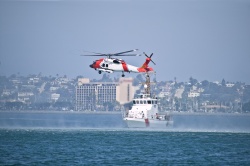If you wish to contribute or participate in the discussions about articles you are invited to contact the Editor
Galileo Search and Rescue Service
| GALILEO | |
|---|---|
| Title | Galileo Search and Rescue Service |
| Author(s) | GMV |
| Level | Basic |
| Year of Publication | 2011 |
Galileo Support to Search and Rescue Service (SAR) represents the contribution of Europe to the international COSPAS-SARSAT co-operative effort on humanitarian Search and Rescue activities. Galileo is to play an important part of the Medium Earth Orbit Search and Rescue system (MEOSAR). Galileo satellites will be able to pick up signals from emergency beacons carried on ships, planes or persons and ultimately send these back to national rescue centres. From this, a rescue centre can know the precise location of an accident. At least one Galileo satellite will be in view of any point on Earth so near real-time distress alert is possible. In some cases, feedback could be sent back to a beacon, something which is only made possible by Galileo.[1]
The COSPAR-SARSAT Mission
The International COSPAS-SARSAT Programme provides accurate, timely, and reliable distress alert and location data to help search and rescue authorities assist persons in distress. The objective of the Cospas-Sarsat system is to reduce, as far as possible, delays in the provision of distress alerts to Search and Rescue (SAR) services, and the time required to locate a distress and provide assistance, which have a direct impact on the probability of survival of the person in distress at sea or on land.[2]
To achieve this objective, Cospas-Sarsat Participants implement, maintain, co-ordinate and operate a satellite system capable of detecting distress alert transmissions from radiobeacons that comply with Cospas-Sarsat specifications and performance standards, and of determining their position anywhere on the globe. The distress alert and location data is provided by Cospas-Sarsat Participants to the responsible SAR services.
Cospas-Sarsat co-operates with the International Civil Aviation Organization, the International Maritime Organization, the International Telecommunication Union and other international organisations to ensure the compatibility of the Cospas-Sarsat distress alerting services with the needs, the standards and the applicable recommendations of the international community.
Galileo contribution (SAR/Galileo)
The Galileo support to the Search and Rescue service - herein called SAR/Galileo - represents the contribution of Europe to the international COSPAS-SARSAT cooperative effort on humanitarian Search and Rescue activities. SAR/Galileo shall: [3]
- Fulfil the requirements and regulations of the International Maritime Organization (IMO) - via the detection of Emergency Position Indicating Radio Beacons (EPIRBs) of the Global Maritime Distress Security Service and of the International Civil Aviation Organisation (ICAO) via the detection of Emergency Location Terminals (ELTs).
- Be backward compatible with the COSPAS-SARSAT system to efficiently contribute to this international Search and Rescue effort.
SAR/Galileo will allow for important improvements of the existing COSPAS-SARSAT system:
- near real-time reception of distress messages transmitted from anywhere on Earth (the average waiting time is currently one hour);
- precise location of alerts (a few meters for EPIRBs and ELTs equipped with Galileo receivers, while the current specification for location accuracy is 5 km);
- multiple satellite detection to avoid terrain blockage in severe conditions;
- increased availability of the space segment (27 Medium Earth Orbit satellites on top of the four Low Earth Orbit satellites and the three Geostationary satellites in the current system).
In addition, SAR/Galileo will introduce a new SAR function, namely, the return link from the SAR operator to the distress emitting beacon, thereby facilitating the rescue operations and helping to identify and reject the false alerts. The service is being defined in cooperation with COSPAS-SARSAT, and its characteristics and operations are regulated under the auspices of IMO and ICAO. [1]
Performance and features
The Search and Rescue Transponder on Galileo satellites detects the distress alert from any COSPAS-SARSAT beacon emitting an alert in the 406 – 406.1 MHz band, and broadcasts this information to dedicated ground stations in the “L6” band. COSPAS-SARSAT Mission Control Centres (MCC) carry out the position determination of the distress alert emitting beacons, once they have been detected by the dedicated ground segment.
The Service performances for the Galileo Search and Rescue Service are described in next table: [3]
| Galileo support to Search and Rescue Service (SAR/Galileo) | |||
|---|---|---|---|
| Capacity | Each satellite shall relay signals from up to 150 simultaneous active beacons | ||
| Forward System Latency Time | The communication from beacons to SAR ground stations shall allow for the detection and location of a distress transmission in less than 10 min. The latency time goes from beacon first activation to distress location determination. | ||
| Quality of Service | Bit Error Rate < 10e-5 for communication link: beacon to SAR ground station. | ||
| Acknowledgment Data Rate | 6 messages of 100 bits each, per minute. | ||
| Availability | > 99.8% | ||
For more information about Performances of each Galileo Service see the article Galileo Performances.
Implementation
The Galileo Search and Rescue Service will be initially provided and tested during the Initial Operation (IOC) Phase, as from 2014-2015 when the first 18 satellites are operational.[4]

